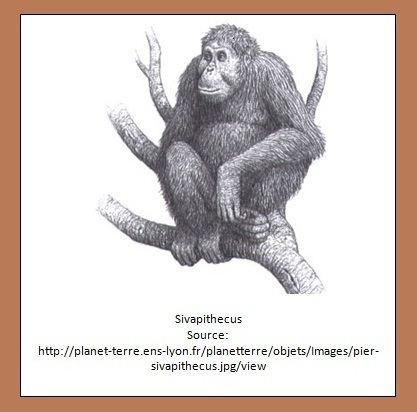Rank Genus | Phylum Chordata Scientific name Sivapithecus | |
 | ||
Similar Dryopithecus, Ape, Great apes, Primate, Proconsul | ||
Interesting article about sivapithecus indicus
Sivapithecus (Shiva's Ape) (syn: Ramapithecus) is a genus of extinct apes. Fossil remains of animals now assigned to this genus, dated from 12.2 million years old in the Miocene, have been found since the 19th century in the Siwalik Hills in the Indian Subcontinent. Any one of the species in this genus may have been the ancestor to the modern orangutans.
Contents
- Interesting article about sivapithecus indicus
- Sivapithecus sivalensis mandible fragment 2
- Discovery
- Description
- Species
- References

Some early discoveries were given the separate names Ramapithecus (Rama's Ape) and Bramapithecus (Brahma's Ape), and were thought to be possible ancestors of humans. This view is no longer considered tenable.
Sivapithecus sivalensis mandible fragment 2
Discovery
The first incomplete specimens of Sivapithecus were found in northern India in the late 19th century.

Another find was made in Nepal on the bank of Tinau River, Butwal; a western part of the country in 1932. This find was named "Ramapithecus". The discoverer, G. Edward Lewis, claimed that it was distinct from Sivapithecus, as the jaw was more like a human's than any other fossil ape then known, a claim revived in the 1960s. At that time, it was believed that the ancestors of humans had diverged from other apes 14 million years ago. Biochemical studies upset this view, suggesting that there was an early split between orangutan ancestors and the common ancestors of chimpanzees, gorillas and humans.
Meanwhile, more complete specimens of Ramapithecus were found in 1975 and 1976, which showed that it was less human-like than had been thought. It began to look more and more like Sivapithecus, meaning that the older name must take priority. It is also possible that fossils assigned to Ramapithecus belonged to the female form of Sivapithecus. They were definitely members of the same genus. It is also likely that they were already separate from the common ancestor of chimps, gorillas and humans, which may be represented by the prehistoric great ape Nakalipithecus nakayamai. Siwalik specimens once assigned to the genus Ramapithecus are now considered by most researchers to belong to one or more species of Sivapithecus. Ramapithecus is no longer regarded as a likely ancestor of humans.

In 1982, David Pilbeam published a description of a significant fossil find, formed by a large part of the face and jaw of a Sivapithecus. The specimen bore many similarities to the orangutan skull and strengthened the theory (previously suggested by others) that Sivapithecus was closely related to orangutans.
Description

Sivapithecus was about 1.5 metres (4.9 ft) in body length, similar in size to a modern orangutan. In most respects, it would have resembled a chimpanzee, but its face was closer to that of an orangutan. The shape of its wrists and general body proportions suggest that it spent a significant amount of its time on the ground, as well as in trees. It had large canine teeth, and heavy molars, suggesting a diet of relatively tough food, such as seeds and savannah grasses.
Species
Currently three species are generally recognized:
